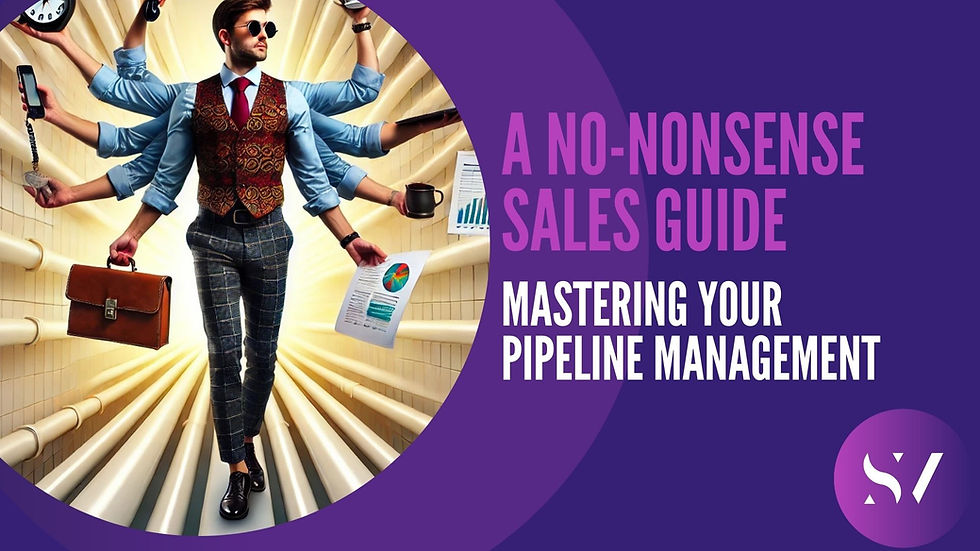Mastering Your Sales Pipeline: A No-Nonsense Guide for Salespeople Who Want to Win
- Sara Osterholzer
- Nov 19, 2024
- 7 min read
Updated: Jan 15
Let’s be honest. Sales pipelines are one of those things that everyone talks about but rarely do sales person use them to their full potential. They’re often either too complicated, ignored entirely, or filled with deals that never get looked at again.
But here’s the truth: a well-managed pipeline is your secret weapon. It’s the difference between flying by the seat of your pants and consistently smashing your targets. So, if you’re an Account Executive, a 360 salesperson, or just starting out in sales, grab a coffee (or something stronger - we won’t judge), and let’s cut through the fluff.

What is a "Sales Pipeline"?
Picture a pipeline - not the glamorous kind carrying gold or oil, but something functional. Water. That’s your sales process.
The Source: Leads flow in from outbound campaigns, referrals, or the occasional stroke of luck.
The "Pipeline" Itself: This represents the structured journey a lead takes from the first interaction to becoming a customer.
"Managing the Flow": Just like a real pipeline needs to be monitored and maintained to ensure smooth flow and prevent blockages, your sales pipeline requires active management.
The Destination: Closed deals. Happy customers. Commission in your pocket.
Managing this pipeline is crucial because, unlike water, leads don’t move on their own. They need nudging, guiding, and sometimes a gentle shove to the next stage. A leaky pipeline (or one clogged with dead-end deals) costs time, effort, and revenue.
Why Pipeline Management Matters
Managing your pipeline isn’t just about moving deals along - it’s about owning your process. Here’s what’s in it for you:
Efficiency: Stop wasting time on unqualified leads and focus on deals that matter.
Better Conversion Rates: Find and fix the stages where deals go to die.
Predictability: No more guesstimating your numbers - forecast revenue with actual data.
Shorter Sales Cycles: Less time faffing about means quicker closes.
In short, a tidy, well-run pipeline keeps you in control and one step ahead. And who doesn’t love being one step ahead?
Your Blueprint for Success
Pipeline stages are like the scaffolding of your sales process - without them, everything feels chaotic and unsteady. Think of them as the step-by-step guide that keeps you on track, helping you manage deals with clarity, focus, and precision. Here’s why they matter and how to make them work for you:
1. Organisation and Clarity
No one likes a messy pipeline (or a messy desk). Structured stages turn chaos into clarity, giving you a clear view of where every deal stands. Instead of guessing, you’ll always know which leads are ready to close and which need a bit more TLC.
2. Clear Actions and Accountability
Each stage should come with specific tasks for you or your team to complete. For instance, during the "Qualification" stage, your goal might be to confirm the lead’s budget or timeline. This ensures everyone knows their role—and eliminates the awkward “who’s doing what” moments.
3. Spotting Bottlenecks Early
Notice a trend where deals seem to stall at the same stage? That’s your signal to dig deeper. Whether it’s unclear next steps, slow follow-ups, or customer hesitations, identifying bottlenecks helps you fix issues before they derail your sales process.
4. Tailored Communication for Each Stage
One-size-fits-all messaging? Forget it. Each stage calls for a different approach.
For example:
Early-stage leads need light-touch conversations to build interest.
Prospects in the "Proposal Sent" stage? They’re expecting detailed answers and reassurance before committing.
Tailoring your tone and info at every step builds trust and keeps deals moving forward.
5. Data-Driven Forecasting
Every stage comes with its own win probability. For example, a lead at "First Contact" might have a 10% chance of closing, while "Negotiation" could hit 75%. Using these numbers, you can project revenue more accurately and allocate resources wisely - no more finger-in-the-air guessing.

Breaking Down the Pipeline Stages
Here’s a quick tour of the stages that make up a well-oiled pipeline. Remember, these stages aren’t just buzzwords - they’re your roadmap to closing deals.
Marketing Qualified Lead (MQL): They’ve clicked your ad or downloaded your whitepaper. They’re curious but not committed - yet.
Sales Qualified Lead (SQL): Budget? Check. Authority? Check. Need and timeline? Double-check. Time to have a proper chat.
Meeting/Pitch: The moment of truth. Understand their problems, wow them with your solution, and leave them thinking, “Why haven’t we done this already?”
Proposal Sent: Your tailored plan is out there. Keep communication tight, and don’t let this stage drag on.
Negotiation/Review: Brace yourself for objections, curveballs, and budget quibbles. Handle it like a pro.
Paid Trial: For those sitting on the fence, offer a low-risk way to try before they buy.
Closed Won/Lost: Celebrate the wins. Learn from the losses. Even a “no” today could be a “yes” later.
Key Metrics for a Healthy Pipeline
Your pipeline isn’t just a fancy chart - it’s your sales lifeline. And like any good lifeline, it needs regular check-ups to stay in top shape. Here are the key metrics you should be tracking to make sure your pipeline is working with you, not against you:
Pipeline Value: This is the sum of all deals currently in your pipeline. Think of it as your “potential revenue” snapshot.
Number of Deals: How many plates are you spinning? Tracking the number of deals at each stage helps you understand your pipeline’s capacity (or whether it’s getting a little too crowded).
Average Deal Size: Keep an eye on the average value of your deals - are they growing over time? If not, it might be time to adjust your targeting or upselling strategy.
Sales Cycle Length: How long does it take, on average, to close a deal? Shorter cycles mean faster wins and more momentum.
Conversion Rates: Track how many leads move from one stage to the next. For example, are MQLs turning into SQLs? If not, what’s stopping them?
Win Rate: What percentage of deals actually close? If it’s too low, it might be time to sharpen your pitch or tighten your qualification process.
Churn Rate: Are customers sticking around or disappearing after the honeymoon phase? A high churn rate means you’re losing more revenue than you should be.
Customer Acquisition Cost (CAC): How much are you spending to win each customer? If CAC is higher than what they’re worth, you’ve got a problem.
Customer Lifetime Value (CLTV): How much revenue will a typical customer bring in over their relationship with your business? Focus on retention, and this number will climb.
By keeping these metrics front and centre, you’ll have a clear roadmap for what’s working, what’s not, and where you can make your sales process leaner and meaner.
Don’t Forget the Human Touch
It’s easy to get caught up in the metrics and processes (and yes, they’re important), but at the end of the day, sales is about one thing: people. The human element is what turns leads into loyal customers.
Here’s how to keep it real:
Listen Actively: Put down the script and really hear what your prospect is saying. Understanding their pain points is the first step to solving them.
Provide Value at Every Stage: Even if a deal doesn’t close today, make sure they walk away with something valuable - whether that’s advice, a resource, or a better understanding of their own needs.
Build Rapport and Trust: Sales isn’t about being pushy - it’s about being real. Be authentic, show you care, and prove you’re here to help, not just to hit quota.
Celebrate the Wins: Whether it’s a closed deal or finally cracking that tough lead, take the time to celebrate. Sales is hard work - you’ve earned it.
Because here’s the secret: when you combine a structured pipeline with genuine human connection, you create a sales process that’s not just effective, but memorable. And that’s what keeps customers coming back.

Proven Strategies for a Winning Pipeline
Let’s get practical. These tips will help you whip your pipeline into shape:
Define and Standardise Your Process: Consistency is key. Define clear steps for each stage and stick to them.
Utilise Technology: Leverage a robust CRM system, like Apollo or Hubspot, to centralise your pipeline management.
Qualify Thoroughly: Use frameworks like BANT (Budget, Authority, Need, Timeline) to separate the serious buyers from the time-wasters.
Control the Timeline: Don’t leave next steps open-ended. Propose specific dates for follow-ups and reviews to keep deals moving.
Offer Paid Trials Strategically: Frame trials as value-packed opportunities rather than freebies. They should give prospects a taste of success, not just a sample.
Review and Refine Regularly: Look at conversion rates for each stage. Are deals stalling after the proposal? Maybe it’s time to revamp your pitch or pricing structure.
Common Pitfalls to Avoid
Even the best pipelines can derail if you’re not careful. Watch out for these classic mistakes:
Overloading with Unqualified Leads: Your pipeline isn’t a recycling bin for every name in your CRM. Qualify leads properly or risk wasting time on the wrong prospects.
Letting Deals Stall: If a deal’s been stuck for weeks, it’s not going anywhere. Be bold - move it forward or move on.
Over-Promising in Negotiation: Saying “yes” to everything just to get the deal signed will only cause headaches later. Stay firm but fair.
Skipping Data Analysis: Your pipeline tells you where deals stall and why. Ignoring this data is like driving without a map - good luck hitting your targets.
FAQs: Let's Clear Up the Confusion
Q: How many stages should my pipeline have?
A: Enough to cover the key milestones, but not so many that it feels like running a marathon. Five to seven stages is usually a sweet spot.
Q: How often should I update my pipeline?
A: Weekly is ideal. This keeps it fresh and ensures nothing slips through the cracks.
Q: What if a deal goes cold?
A: Don’t be afraid to re-engage. A polite nudge or sharing something valuable (like a case study) can reignite interest.
Q: Should I use a CRM?
A: Absolutely. Tools like HubSpot or Apollo make tracking and managing your pipeline a breeze. Plus, you’ll look incredibly organised in front of your manager.
The Bottom Line
A well-managed sales pipeline isn’t just a nice-to-have - it’s the backbone of your success. Get it right, and you’ll close more deals, hit your targets, and sleep better at night (maybe). Sure, it takes effort, but the payoff? Totally worth it.



